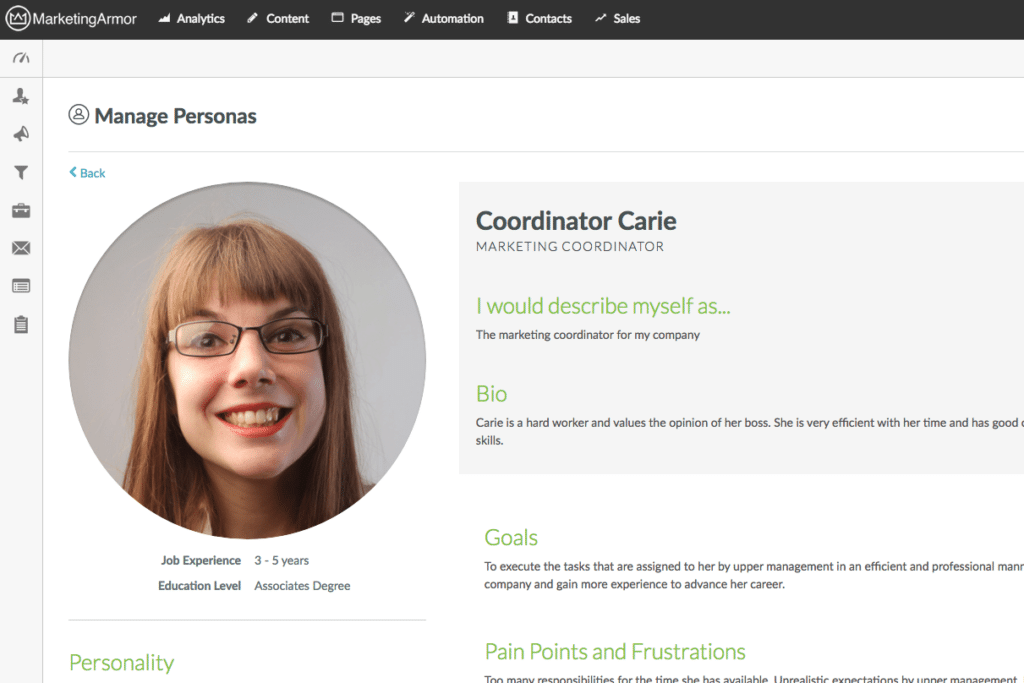One of the biggest mistakes that can be made when developing a marketing strategy is to focus on a broad target audience instead of creating well-defined buyer personas. Many businesses want to target as many prospects as possible in order to bring in more leads, however this does not equal a profitable strategy. A buyer persona is an in depth description of a set of customers that includes geographic, demographic and psychographic characteristics, as well as buying patterns and purchase history. Creating detailed buyer personas forces you to think about the customers that you want to target, and how to target them.
Creating your personas allow you to:
- Visualize your customer. Thinking in detail about your prospects needs allow you to create marketing that is empathetic and aligns with their purchasing behaviors.
- Gain better direction in your marketing message. All elements of your marketing, including your copy, imagery, tone of voice, and calls to action, allow you to create very targeted blogs, ads and emails that will resonate with your ideal customer.
- Prioritize messaging. You will be able to decide what benefits or features you want to prioritize based on the needs of your prospects.
The Creation of a Buyer Persona
Many businesses assume that the identification of their ideal customers for their personas is a step that will only occur once. However, this is not the case. Companies that continue to evaluate and improve their personas as their customer base evolves will have more success than companies who don’t. This process isn’t something that needs to be done every week, or every month. Instead reviewing these processes quarterly will allow you to measure the success of your strategies with enough time to actually determine what worked and what didn’t.
3 Step Process To Identify Your Buyer Personas
In order to identify your ideal buyer persona, you first need to review your current client roster. Here you will breakdown the evaluation of clients into 3 categories, and then establish criteria in each category to match the products and services of your business. Connecting with current customers will help you to better understand their purchasing processes and what drives them to purchase from your business. Some examples of criteria for the categories include: revenue paid to your company annually, willingness to be a reference for your company in the sales process, and length of customer relationship. You will use this criteria to sort through your current client roster to create a master list of your “best customers” comprised of those that are the highest scoring.
The second step is to discover what your ideal customers have in common. This could be anything from shared geographic location to a shared partnership with another company. Other commonalities could include annual revenue and industry type. For business to business relationships, elements such as number of employees, title of person who authorized the purchase and title of person who drove the purchasing process should be examined. This will allow you to develop clear cut guidelines for identifying those that you should be targeting.
The third and final step is to reach out to the key decision makers, whether they are individual customers or businesses, to discuss their needs in detail directly with them.
Implementing buyer personas into your overall marketing strategy will help to narrow the focus of your business so that the customers that you do target are receptive to the information you send them. You can create as many different buyer personas as necessary in order to best and accurately target all of your ideal prospects with messaging that will be meaningful to each of them.
Contact us to learn more about creating buyer personas through our marketing automation platform today.
References: Gracey, Peter. "Who Is Your Ideal Customer? Three Simple Ways to Find Your Target Market." MarketingProfs. N.p., 22 Aug. 2012. Web. 24 Mar. 2017. Kumedan, Subir. "Seven Common Mistakes Marketers Make." MarketingProfs. N.p., 26 Jan. 2016. Web. 24 Mar. 2017.




